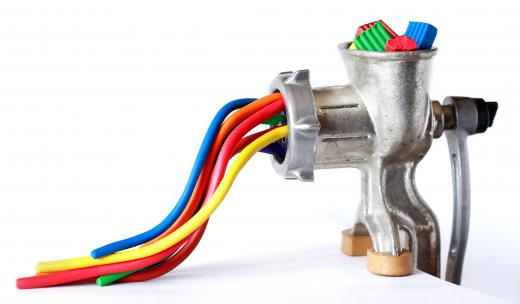Extrusion, from the Latin past participle extrudere meaning “to thrust out,” refers both to the process in which material is forced through a die or series of dies in order to shape it as well as to the product of that operation. The process is used in the home and in manufacturing. The shapes most often produced in this way include round objects like tubes, rods, and pipes, rectangular objects like solid and hollow bars, and plates. The term also refers to the outpouring of lava from a volcano.
In the home, the most familiar example of extrusion may be the pastry bag. Used to form cookies and to frost cakes, the pastry bag extrudes icing or dough through a tip that shapes the output. This is done in short bursts to produce a set of identical items quickly. Kitchen equipment that makes pasta or sausage may also feature an extruder that shapes the finished product. A very popular extruder toy is sold with modeling compound, in which a user selects a die and slides it across the front of the machine, inserts the soft material, and presses the handle to produce either long or short pieces of clay in the shape desired.

In manufacturing, extrusion is used with a variety of materials, including metal, plastic, ceramics, and food. Different materials undergo this process to make different types of products. Copper is extruded to make pipes for plumbing, while aluminum is used to make things like window frames, tracks, and railings. Steel is extruded into tracks or rods, and some titanium aircraft parts are produced this way. Plastic extrusion results in an array of shapes, including cylindrical tubes, pipes, and rods, rails, and very thin rectangular surfaces that are characterized as sheets or films.

Food manufacturing uses extrusion in ways that go beyond what is possible in the standard home kitchen. Cheese curls and other snacks, pastas, cereals, and nutritional bars all are made with this process, as are a number of pet foods. In fact, extruded foods is a food science specialty, and scientists who have training and experience in this particular realm of food manufacturing oversee these processes. There is debate over whether making food this way, in at least some cases, reduces the nutritional quality of the item.

